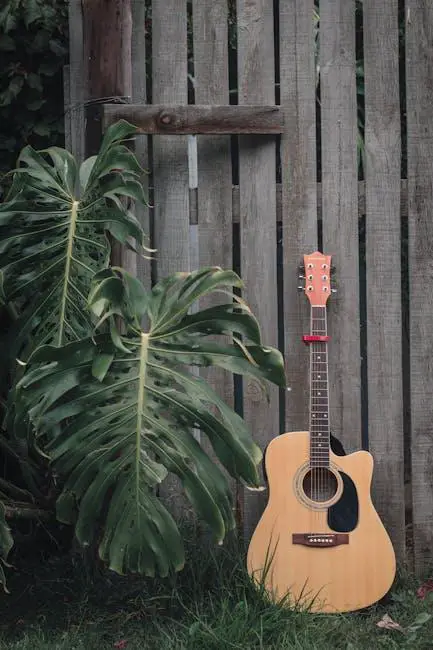So you’ve picked up a guitar and decided to master the art of shredding like a rock god, but there’s just one tiny problem – your guitar’s action is about as high as Snoop Dogg at a reggae concert. Fear not, aspiring axemen and axe-women, for in this DIY guide, we will show you how to perfect your guitar’s action and get those strings vibrating like a seasoned pro. Grab your tools and buckle up, because we’re about to dive deep into the mystical world of guitar setup.
Contents
- 1 Understanding Guitar Action and Its Impact on Playability
- 2 Setting Up Your Workspace and Gathering the Necessary Tools
- 3 Evaluating Your Guitar’s Current Action and Identifying Adjustments
- 4 Step-by-Step Process for Lowering the Action on an Electric Guitar
- 5 Adjusting the Action on Acoustic Guitars for Improved Comfort and Tone
- 6 Troubleshooting Common Issues After Adjusting Guitar Action
- 7 Maintaining Optimal Action and When to Seek Professional Help
- 8 FAQs
- 9 Rock on, guitar aficionados!
Understanding Guitar Action and Its Impact on Playability
In the world of guitars, one term you may come across is “action.” But what exactly does this mean, and how does it impact your playing experience? Let’s dive into the fascinating world of guitar action and its quirky effects on playability.
Picture this: you pick up a guitar, ready to shred like a rock star, only to find that the strings are practically touching the fretboard. This is an example of low action, where the strings are set close to the fretboard. On the flip side, high action refers to strings that are set farther away from the fretboard. The question is, which is better for playability?
Low action may seem like the obvious choice for faster playing and easier fretting. However, high action can also have its benefits. Let’s break it down:
- Low Action: Easier to play fast licks and solos, less finger fatigue, smoother bending and vibrato.
- High Action: Better tone and sustain, reduced fret buzz, more room for aggressive picking.
Setting Up Your Workspace and Gathering the Necessary Tools
When it comes to setting up your workspace, you want to make sure you have all the necessary tools at your disposal. After all, you can’t build a spaceship with just a hammer and some duct tape (although it would make for an interesting design).
First things first, make sure you have a comfortable chair. You’re going to be spending a lot of time sitting at your desk, so you might as well do it in style. Plus, it’s the perfect excuse to get that ergonomic massage chair you’ve had your eye on.
Next, gather all the tools you’ll need to bring your creative vision to life. Whether it’s a sketchbook, a set of colored pencils, or a trusty computer, make sure you have everything within arm’s reach. And don’t forget the snacks – because let’s be honest, no creative session is complete without a bag of chips or two.
So, grab your tools, take a seat in your plush massage chair, and get ready to conquer the creative world. Your workspace is your kingdom, and with the right tools and a sprinkle of imagination, there’s no limit to what you can accomplish. Now, go forth and create!

Evaluating Your Guitar’s Current Action and Identifying Adjustments
So you’ve picked up your trusty guitar and you’re ready to rock out, but wait! Is your guitar’s action holding you back from reaching your full potential? Let’s take a closer look and see if some adjustments might be in order.
First things first, grab a capo and place it on the first fret. Then, press down on the last fret and check the distance between the string and the frets in the middle of the neck. If there’s too much space, your action might be too high. If there’s barely any space at all, your action might be too low.
Next, take a look at the bridge of your guitar. Are the screws holding the saddle in place loose or tight? If they’re loose, you might need to tighten them to raise the action. If they’re tight, you might need to loosen them to lower the action.
Don’t forget to also check the truss rod. If your neck is too bowed or too flat, it can affect your action. Use a hex key to make small adjustments until the neck is just right. And voila! Your guitar is now ready to take on the world with its perfectly adjusted action.

Step-by-Step Process for Lowering the Action on an Electric Guitar
So, you’re tired of feeling like you’re playing on a bridge made of razor blades every time you pick up your electric guitar? Fear not, my friend, for I have the step-by-step process to help you lower that action and make your playing experience infinitely more enjoyable.
First things first, grab your trusty screwdriver and let’s dive into the belly of the beast that is your guitar. Remove the back panel to reveal the magical realm of truss rod adjustments and bridge saddles. It’s like Narnia, but with more tuning pegs.
Next, let’s tackle the truss rod. Loosen that bad boy (or girl, no judgments here) to give your neck a little breathing room. Just remember: lefty loosey, righty tighty. Unless you’re upside down, then all bets are off.
Now, onto the bridge saddles. Take a moment to appreciate the craftsmanship of these tiny metal warriors that bear the brunt of your musical genius. Use your screwdriver to lower them just a smidge, but not too much – we’re aiming for a sweet spot, not a fretboard disaster. Remember, a little goes a long way.
Once you’ve made your adjustments, restring your guitar and give it a test drive. Play a few chords, shred a killer solo, or serenade your cat – whatever tickles your fancy. If the action still feels too high, repeat the process until you achieve that magical balance of comfort and playability. And voila! You’ve successfully lowered the action on your electric guitar. Now go forth and rock on, my friend.
Adjusting the Action on Acoustic Guitars for Improved Comfort and Tone
So, you’ve just picked up your acoustic guitar and realized that the action is higher than Mount Everest. Fear not, brave guitarist, for I am here to guide you through the treacherous journey of adjusting the action on your beloved six-string companion.
First things first, grab yourself a trusty allen wrench and get ready to embark on this adventure. Before you start turning those pesky truss rod screws, take a moment to appreciate the valiant effort your guitar has made thus far in withstanding the high action levels. Now, let’s get down to business.
**Here are some key steps to follow for adjusting the action on acoustic guitars**:
- Loosen the strings
- Adjust the truss rod
- Saddle height adjustment
Keep in mind that adjusting the action is all about finding that sweet spot where comfort meets tone. So, take your time, experiment with different adjustments, and most importantly, have fun along the way. Remember, a well-adjusted guitar is a happy guitar, and a happy guitar makes for a happy guitarist. Rock on!
Troubleshooting Common Issues After Adjusting Guitar Action
So, you’ve decided to take matters into your own hands and adjust your guitar’s action. Good for you! But now you’re faced with a few common issues that might be throwing a wrench in your rockstar dreams. Don’t fret (pun intended), we’ve got some troubleshooting tips to help you get back on track.
1. Buzzing strings: If your strings are buzzing against the frets, it could be a sign that you’ve lowered the action too much. Try raising the action slightly and see if that solves the problem.
2. Intonation problems: If your guitar is out of tune even after adjusting the action, it might be an issue with the intonation. Make sure your strings are properly intonated by adjusting the saddle positions.
3. High action: On the flip side, if your action is too high, it can make playing a real pain in the neck (literally). Lower the action gradually until it feels comfortable to play, but be careful not to go too low and cause buzzing.
Remember, guitar setup is a delicate balancing act, so don’t be afraid to experiment until you find the perfect setup for your playing style. And if all else fails, maybe it’s time to call in the professionals for a little tune-up.
Maintaining Optimal Action and When to Seek Professional Help
When it comes to maintaining optimal action, it’s important to stay proactive and address any issues before they escalate. Here are some tips to keep you on track:
- Stay organized by creating a to-do list and prioritizing tasks.
- Take regular breaks to avoid burnout and keep your energy levels up.
- Communicate effectively with your team to ensure everyone is on the same page.
- Stay positive and motivated by setting achievable goals and celebrating your successes.
However, if you find yourself struggling to keep up with your workload or consistently feeling overwhelmed, it may be time to seek professional help. Here are some signs that it’s time to reach out to a professional:
- You’re feeling constantly stressed and unable to relax.
- You’re experiencing physical symptoms such as headaches or stomach problems.
- Your work performance is suffering and you’re struggling to meet deadlines.
- You’re relying on unhealthy coping mechanisms such as overeating or excessive drinking.
FAQs
How can I tell if my guitar’s action needs adjusting?
Well, first you can try playing a few chords. If your fingers feel like they’re doing a workout at the gym, it’s probably time for an action adjustment. Another tell-tale sign is if your strings are so high off the fretboard that you could probably fit a small animal underneath them.
What tools do I need to adjust my guitar’s action?
You’ll need a few basic tools like a screwdriver, some allen wrenches, and a ruler or feeler gauges. And of course, don’t forget a healthy dose of patience and a sprinkle of determination!
Should I attempt to adjust my guitar’s action myself, or should I leave it to the pros?
Well, that depends. Are you the kind of person who’s not afraid to roll up your sleeves and get your hands dirty? Do you have a DIY spirit that could rival Tim “The Toolman” Taylor? If so, go ahead and give it a shot! But if the thought of messing with your precious guitar fills you with fear and dread, it might be best to leave it to the professionals.
How often should I check and adjust my guitar’s action?
Just like how you should probably check your fridge for expired yogurt every once in a while, you should also check your guitar’s action every few months or so. Strings can shift and settle over time, so it’s a good idea to give it a tune-up every now and then.
What are some tips for fine-tuning my guitar’s action to perfection?
When adjusting your guitar’s action, remember that it’s a delicate balance between low enough to play effortlessly and high enough to avoid annoying fret buzz. Take your time, make small adjustments, and don’t be afraid to experiment until you find that sweet spot. And above all, trust your fingers – they’ll let you know when it’s just right.
Rock on, guitar aficionados!
Whether you’re looking to shred like Hendrix or strum like Sheeran, mastering the perfect action on your guitar is key to unlocking your musical potential. With this DIY guide, you’ll be well on your way to achieving that sweet spot that makes playing a dream.
So grab your guitar, crank up the amp, and let the music take you on a wild ride. Remember, practice makes perfect, so don’t be afraid to put in the hours. Before you know it, you’ll be rocking out like a pro.
Keep picking, strumming, and shredding, and don’t forget to have fun along the way. Here’s to many hours of musical bliss ahead!



